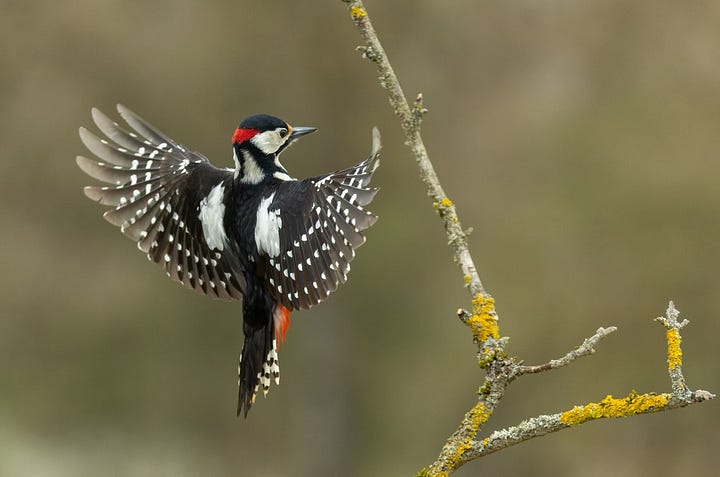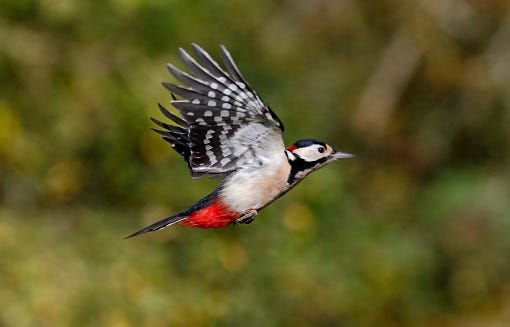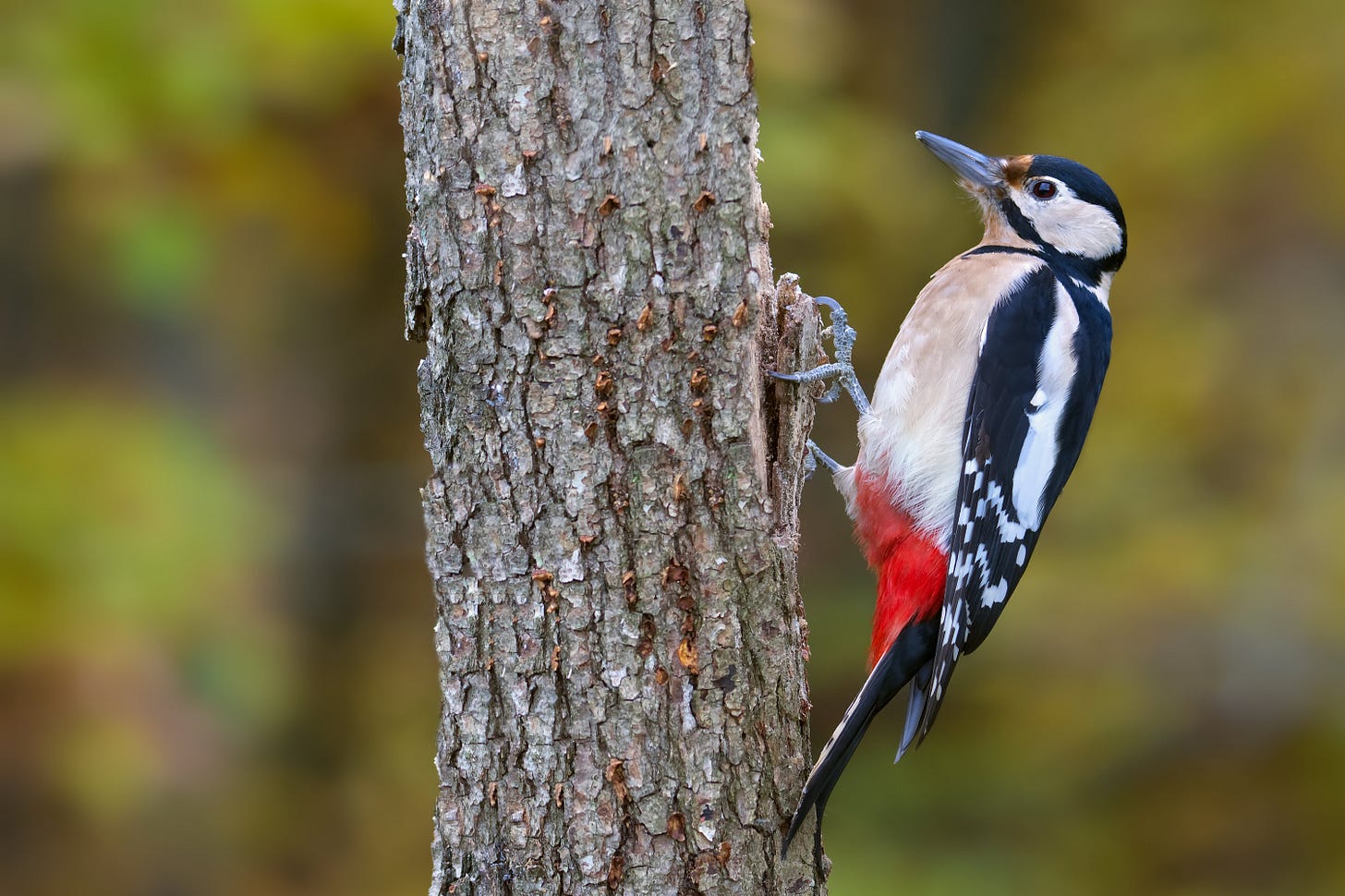That drumming sound you hear could be a woodpecker
For centuries the great spotted woodpecker was extinct in Ireland, but it's been seen and heard in Ballincollig Regional Park, Doneraile, Leap and all across the Blackwater Valley in Cork.
If you go down to the woods today, you might just hear a woodpecker.
And if you’re especially lucky you might even see the great spotted woodpecker which is increasingly being heard and seen in locations across Cork.
In fact, it was the distinctive drumming sound of the woodpecker that first caught the attention of Sachiko Kobayasahi and Fionn Rogan, who heard the bird while out walking earlier this month in Ballincollig Regional Park.
Ms Kobayashi made a recording of the woodpecker, which her husband Mr Rogan uploaded to Twitter. That audio recording got ornithologists at UCC, where Dr Rogan works as a researcher, as well as twitchers, tweeting.
In the recording by Ms. Kobayashi, a distinctive drumming sound can clearly be heard. Unfortunately, she was not able to capture footage of the elusive woodpecker. However, commenters chimed in to say that they had heard the same drumming sound in several locations across the county.
Patrick Smiddy, an ornithologist and co-author of the book The Birds of County Cork told Tripe + Drisheen that reports of the woodpecker have been recorded right across the county from the Blackwater Valley in east Cork as far away as Leap in West Cork and Doneraile in the north of the county.


Woodpeckers in Cork, really?
The short answer is yes, there are woodpeckers in Cork.
As Mr Smiddy told Tripe + Drisheen, since around 2005 the bird has been recolonising in counties along the eastern seaboard, having flown across from the UK where numbers are estimated at around 100,000.
John Quinn, a professor in zoology at UCC, referred T+D to data from the National Biodiversity Data Centre which states that the woodpecker “has continued its dramatic range expansion in Ireland and now occurs in all counties.”
This is a remarkable turnaround.
As professor Quinn wrote in an email, the “great spotted woodpeckers were extinct as a breeding bird in Ireland for a long time, probably since the last Ice Age.”
But, the distinctive bird is very much back, and breeding in Co Wicklow since 2015.
A little bigger than the starling, the great spotted woodpecker is mostly black and white, but has a distinctive red patch near its tail. The birds feed on a diet of insects common to woodlands, but they’ve also been known to stop by bird feeders.
Spring is the best season to catch the woodpecker, or hear them in action, as they put on an impressive percussion performance while drilling into tree trunks to make nests and mark out their territory.


Mr Smiddy said that while the woodpecker can be a bit tricky to spot, you’re likely to be first alerted to it owing to that distictive drumming sound.
“They do what is called drumming, which is hammering the bark of the tree with their bill.”
“They nest in holes in trees, or they’ll make a hole in rotting or dead trees,” Mr Smiddy said, explaining that the great spotted woodpecker wouldn’t be able to make a hole in a living tree.
As researchers in the New York Times noted, woodpeckers have undergone millions of years of evolution to minimise shock absorption, a hugely important evolutionary adaptation given that the bird spends a great deal of its life smashing its face into trees.
Mr Smiddy, who lives near Youghal in east Cork, has yet to see a woodpecker in Cork, but given that he’s currently working on a book about the birds of Ireland, it’s likely only a matter of time before he spots one.
According to Mr Smiddy, DNA testing on the woodpeckers found in Ireland has established that they match closely with woodpecker colonies in Britain.
“The British population has been expanding for the last 20 or 30 years and this is the reason why we have them,” Mr Smiddy said.
“It’s basically overspill from the UK,” he said.


Ecological engineers
UCC president John O’Halloran, an ornithologist, told Tripe + Drisheen that while he has yet to see the woodpecker in Cork, it’s exciting to hear about the sightings of the bird.
Professor O’Halloran described the woodpecker as an “ecological engineer”, explaining that the woodpecker drills holes in the bark of trees which are in turn inhabited by insects, thereby creating habitats for other species.
“Having this animal back in our habitat is just fantastic and I think it captures people’s imagination.”
“I’m envious of my colleagues who have seen the bird,” professor O’Halloran said with a laugh, adding that when he’s out walking near his house in Douglas he has his ears attuned to the woodpecker’s distinctive drumming.
However, he’s been caught out on ocassion. As he explained, crows and rooks also make a very similar drumming sound to the woodpecker, which can be deceiving to the ear.
“I’m constantly on the lookout as they will turn up,” he said.
That’s also the goal for Sachiko Kobayashi, an origami artist originally from Japan but living in Ballincollig. She recalls seeing the bird many years ago in Japan, and now she’s heard it in Cork.
Next up, Ms Kobayashi wants to set eyes on the woodpecker.
If you do come across the great spotted woodpecker, Bird Watch Ireland is asking people to register where they saw it at their portal here.






I heard one hammering away in a tree in Mayo last weekend ..first time I heard a woodpecker 🤔